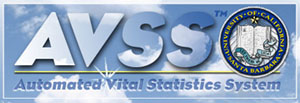
SUMMARY
OF DISCUSSION
Automated
Vital Statistics System
Technical
Advisory Group
2003
Annual Meeting
![]()
1. Introduction By Attendees and Opening Statements.
Meeting participants reviewed the summary of the
Ron Williams of the AVSS Project asked meeting participants
(about 50 individuals) to update contact information on the member roster,
which was distributed in the meeting packet.
1. Version 4.13 Update.
Version 4.13 Release Notes were distributed at the meeting
and are available at www.avss.ucsb.edu.
4.13 is the name for the 2003 version, but it will be released in
2004. It will be alpha-tested in
December 2003. Beta-testing will follow. Release is anticipated for late January
2004. Changes in the 4.13 version are
minor and are discussed in the Release Notes.
Meeting participants reviewed the changes.
2. AVSS Modification Requests (AMRs):
Review and Discussion.
03-001: Ron Williams presented his solution to the problem: When a temporary password is assigned by a
System Manager, the user, when logging on again, must change the temporary
password to a permanent one. AVSS will
automatically go to YOUR PASSWORD option.
Many users are confused as to how to proceed at this point. Ron’s solution: Instead of going to the YOUR PASSWORD
suboption, AVSS should automatically go one level down to the CHANGE YOUR
PASSWORD suboption. AVSS was programmed
to accept this change.
03-029:
Ying-Ling Wang of
As part of
this discussion, a question was raised on whether counties are required to
enter fetal death records into AVSS. The
response was that these entries are not required.
Additionally,
meeting participants discussed proper reporting of fetal deaths and possible
AVSS modifications to preclude inappropriate reports. Some counties are inappropriately entering
fetal death records when the correct reporting would be a birth certificate
followed by a regular death certificate.
03-050:
Ron Williams presented his solution to the problem: The MISSING FILE NUMBER EDITOR can be used to
designate the reason for missing LCAs or CDCs.
This suboption is useful for identifying the reason for a missing
record. However, some of the LRDs have
traditionally “fitted in” missing file numbers with new records using the LFN
ASSIGNMENT suboption. This creates
ambiguity and confusion. Ron’s
solution: Do not allow the LFN
ASSIGNMENT suboption to be applied to any LFNs that have had the MISSING FILE
NUMBER EDITOR suboption previously applied to them. AVSS was programmed to accept this change.
3.
Confidential Morbidity Report.
Stan
Bissell of the Surveillance and Statistics Section (SSS) reported on the
Confidential Morbidity. The “Disease
Investigations and Surveillance Branch” has been renamed back to the
“Infectious Diseases Branch.”
The
Division received additional funds for surveillance as part of the PHIN and
Bioterrorism grants.
CDC funded
projects are moving forward: Electronic
Laboratory-based reporting (ELR)/ California Electronic Laboratory Disease
Alert and Reporting (CELDAR) system: Pilot system about to begin; “Web-CMR”
project moved to PHFE and is moving forward, vendor selection process should be
completed soon. It is likely some
PHIN-compliant system will begin to be deployed in 2004.
CMR form
revisions: likely nothing will happen
until PHIN/”Web-CMR” project is farther along.
IDB is working on a regulation change which will allow for flexibility
adding or deleting diseases from the reportable list (current regulations make
adding new diseases (e.g. SARS) or BT agents (e.g. Smallpox) cumbersome and
untimely.
Case report
forms are available in PDF format and are posted on the web site http://www.dhs.ca.gov/ps/dcdc/dcdcindex.htm
. Click on PUBLICATIONS, then scroll to
FORMS section and click on the link:
Username: cdforms, Password: broadstreet.
4.
Electronic Death Registration.
Mike
Rodrian of the Office of Vital Records reported on the status of electronic
death registration.
Mike also
reported that 2003 legislation requires DHS to develop an EDRS that is
operational in at least one county by January 2005. DHS has decided to contract with UC Davis for
development of the prototype EDRS. DHS
staff are working with UC Davis on this project. Pam Isaac (Humboldt county) is a member of
the project steering committee. Mike
indicated that DHS is looking for other counties to participate in EDRS. Meeting participants asked what is needed for
EDRS participation. Mike indicated that
familiarity with the Internet or AVSS/NET would be helpful because EDRS is
web-based. Natlee indicated that good
working relationships with local funeral directors would also be very
helpful. UC Davis is developing a web
site to keep counties apprised of the status of the project.
5.
New Birth Certificate in 2005.
Mike
reported that Karen Flanigan of CHS/OHIR has been holding meetings with
interested parties on development of modifications to the birth certificate. Legislation will be needed to implement any
modifications. Special topics of
interest are labeling for the parents (changing “mother/father” to “parent”)
and questions on mother’s smoking during pregnancy. Two legislators have expressed interest in
the subject. Mike estimated that the
likelihood of changes is greater for 2006, rather than 2005.
6.
AVSS/NET.
Ron
Williams distributed information on AVSS/NET and discussed system benefits,
costs, components, security, connections, and firewalls (for added
security). This information is also
available on the AVSS website.
7.
AVSS Technical Assistance.
Ron
Williams discussed funding for AVSS technical assistance activities. He distributed and discussed a letter
describing fee arrangements for FY 04-05, a sample invoice with explanation, a
model Renewal Agreement, and a table showing annual AVSS technical assistance
costs, by LRD, from FY 97-98 to current and projected through FY 04-05.
8.
Geocoding
Ron
indicated that AVSS has a contract with DM Information Systems for geocoding
services.
9. Next Meeting
The next
TAG meeting will be scheduled for December 2004, to be held in Sacramento East
End Complex.
11. Adjournment
The meeting
was adjourned at
Acknowledgement: This summary was written by Jessica
McCarroll.
![]()
